This article was published in the July 2008 issue of Australian Labour Market Statistics (cat. no. 6105.0).
MATERNITY LEAVE
INTRODUCTION
The issue of paid maternity leave has achieved increasing prominence in Australia over the past few years, particularly within the context of an ageing population and initiatives to increase the fertility rate in Australia; the ability of Australian families to balance their work and family responsibilities; and concerns over the costs and availability of child care. There has been ongoing debate about whether there should be a paid maternity leave scheme, and if so, who would fund such a scheme.
In response to this, the Productivity Commission has been asked by the current Government to undertake an investigation into paid maternity, paternity and parental leave to "examine ways the Government can provide improved support to parents with newborn children".
In looking at what impact the introduction of a national maternity leave scheme may have, it is important to consider the existing coverage of paid maternity leave. While Australia may be one of only two OECD countries that do not have a government funded maternity leave scheme, many Australian women do have paid maternity leave provided by their employer.
Information on employees (end note 1) entitlements to paid maternity (or paternity) leave (in their main job) is collected by the Australian Bureau of Statistics (ABS) in the Employee Earnings, Benefits and Trade Union Membership (EEBTUM) Survey and the Forms of Employment Survey (FOES).
These surveys are run as annual supplements to the monthly ABS Labour Force Survey (LFS), with EEBTUM conducted in August and FOES conducted in November (the latter on an annual basis since November 2006). Results are released in Employee Earnings, Benefits and Trade Union Membership, Australia (cat. no. 6310.0) and Forms of Employment, Australia (cat. no. 6359.0) respectively.
Information on women's use of paid or unpaid maternity leave is collected in the Pregnancy and Employment Transitions survey (also run as a supplement to the monthly LFS). This survey was last conducted in November 2005, with results released in Pregnancy and Employment Transitions, Australia (cat. no. 4913.0).
This article highlights changes in paid maternity leave coverage over the past five years, and explores some of the characteristics of female employees (end note 1) who have paid maternity leave entitlements. The majority of data for this article is sourced from the August 2007 EEBTUM survey, as there is a longer time series available from this source (i.e. 2002 to 2007), and it also collects a number of characteristics that are useful in the context of analysing maternity leave entitlements, such as weekly earnings and sector of employment.
OVERVIEW
In August 2007, it was estimated that 45% (1.8 million) of the 4 million female employees (end note 1) were entitled to paid maternity leave in their main job (ie the job in which they work the most hours). Paid maternity leave entitlements were twice as prevalent for those working full-time, with 60% of full-time female employees (end note 1) having paid maternity leave entitlements compared with 27% of part-time female employees (end note 1). As a result, almost three-quarters (72%) of all female employees (end note 1) with paid maternity leave entitlements worked full-time.
In contrast, it was estimated that 1.5 million (39%) female employees (end note 1) were not entitled to paid maternity leave, with part-time employees (end note 1) accounting for 70% of this figure.
1. Female employees(a), Whether entitled to paid maternity leave - Aug 2007 |
|  |
 | Full-time |  | Part-time |  | Total |  |  |
 | '000 | % | '000 | % | '000 | % |  |
|  |
| Entitled to paid maternity leave | 1 299.3 | 60.1 | 501.0 | 27.3 | 1 800.3 | 45.0 |  |
| Not entitled to paid maternity leave | 461.0 | 21.3 | 1 081.8 | 58.9 | 1 542.8 | 38.6 |  |
| Did not know | 402.4 | 18.6 | 253.6 | 13.8 | 656.1 | 16.4 |  |
| Total | 2 162.7 | 100.0 | 1 836.4 | 100.0 | 3 999.1 | 100.0 |  |
|  |
| (a) Employees (excluding Owner Managers of Incorporated Enterprises). |
| ABS Survey of Employee Earnings, Benefits and Trade Union Membership. |
It is important to note that for some 650,000 (16%) female employees (end note 1), it was not possible to establish whether they had paid maternity leave entitlements (i.e. did not know), and this needs to be factored into any analysis of data on paid maternity leave entitlements.
The high proportion of 'Did not know' responses can largely be attributed to the Any Responsible Adult (ARA) methodology used in the LFS and supplementary surveys. Under this methodology, one member of the household answers on behalf of all members of that household. As a result, in some instances the person responding to the survey may not be aware of the various entitlements of other members of that household. Another contributing factor is that some people may not actually be aware of their own entitlements until such time as they are directly relevant to them.
Analysis of the 'Did not know' group does not highlight any significant disproportionate distribution across the range of demographic and labour market characteristics. For example, when looking at 'Did not know' responses by age, while there was a slight dip for female employees (end note 1) in their thirties, overall the proportion of female employees in the 'Did not know' group remains relatively consistent across the ages (generally between 10% to 20%). Therefore, it seems likely that the 'Did not know' responses would be spread proportionally across the 'Entitled' and 'Not entitled' groups.
Between August 2002 and August 2007, the proportion of female employees (end note 1) entitled to paid maternity leave increased from 31% to 45% (Graph 2). This represents an additional 700,000 female employees (end note 1) with paid maternity leave entitlements. The proportion of female employees (end note 1) without paid maternity leave entitlements decreased over this period, as did the proportion of female employees (end note 1) for whom it was not possible to establish whether they had paid maternity leave entitlements.
2. Female employees(a), Whether entitled to paid maternity leave
- Aug 2002 to Aug 2007
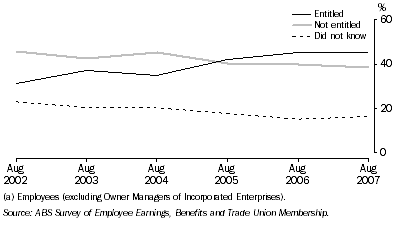
Over the 5 year period to August 2007, the proportion of full-time female employees (
end note 1) who were entitled to paid maternity leave increased from 43% to 60%, while for part-time female employees (
end note 1) the corresponding increase was from 18% to 27% (Graph 3).
3. Female employees(a) entitled to paid maternity leave, by Full-time or Part-time status
- Aug 2002 to Aug 2007
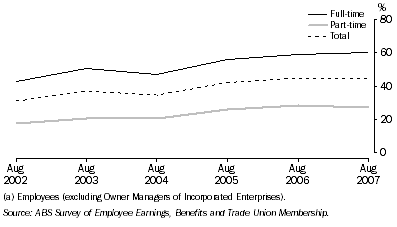
The remainder of this article focuses on the characteristics of those female employees (
end note 1) who had paid maternity leave entitlements.
AGE
Paid maternity leave entitlements vary across the life cycle. Graph 4 shows that there is a sharp increase in paid maternity leave entitlements for female employees (end note 1) between 15 years of age and the late-twenties, and a marked decrease from the early-fifties into the older ages. However, for female employees (end note 1) between these two age groups, paid maternity leave entitlements remain fairly consistent, albeit with some variability (within a range of 46% to 56% in 2007).
The lower incidence of paid maternity leave entitlements in the younger and older age groups reflects the high incidence of part-time employment in these age groups. For example, in August 2007, 55% of female employees (end note 1) aged 15 to 24 years and 57% of female employees (end note 1) aged over 60 years were employed part-time (in their main job). In contrast, just 43% of female employees (end note 1) aged 25 to 59 years were employed part-time (in their main job).
In August 2007, the incidence of female employees (end note 1) with paid maternity leave entitlements was generally higher for those female employees (end note 1) aged from their late-twenties to their mid-thirties, although there was also a peak for female employees (end note 1) in their early-fifties. For full-time female employees (end note 1), the peak was within this same age range, while for part-time employees (end note 1), the peak occurred slightly later (mid to late-thirties).
In comparison, the median age of all mothers who gave birth (in 2006) was 31 years (Births, Australia, 2006 (cat. no. 3301.0)).
Between August 2002 and August 2007, the incidence of female employees (end note 1) with paid maternity leave entitlements increased across all ages, although the increases were greater for those aged over 25 years of age.
4. Female employees(a) entitled to paid maternity leave, by Age
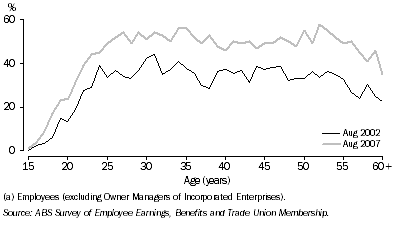
WEEKLY EARNINGS
There is a high correlation between earnings and the entitlement to paid maternity leave. The mean weekly earnings (in main job) of female employees (
end note 1) who were entitled to paid maternity leave was $908, compared with $487 for female employees (
end note 1) without paid maternity leave entitlements. This large difference reflects, in part, the large numbers of part-time employees (
end note 1) without paid maternity leave entitlements. When focussing on full-time female employees (
end note 1) only, the difference in mean weekly earnings between those female employees (
end note 1) with and without paid maternity leave entitlements was much lower ($1,036 compared with $878).
Looking at the earnings distribution, the proportion of female employees (end note 1) entitled to paid maternity leave increases as earnings increase, before flattening out once earnings exceed around $1,200 per week. In August 2007, female employees (end note 1) who earned between $1,400 and $1,600 per week had the highest incidence of paid maternity leave entitlements (77%). For full-time female employees (end note 1) the peak was in the $1,800 to $2,000 per week range (79%), while for part-time employees (end note 1) the peak was in the $1,000 to $1,200 per week range (64%).
Between August 2002 and August 2007, increases in paid maternity leave entitlements were concentrated among the higher earners, with only small increases in paid maternity leave entitlements for female employees (end note 1) earnings under $1,000 per week.
5. Female employees(a) entitled to paid maternity leave, by Mean Weekly Earnings in main job
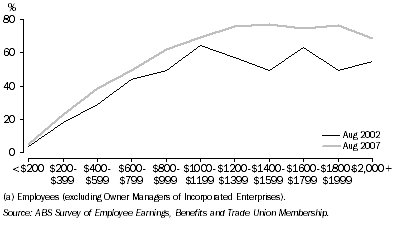
HOURS PAID FOR
While there was a considerable disparity in paid maternity leave entitlements between full-time and part-time female employees (
end note 1) (60% compared with 27%), looking at paid maternity leave entitlements according to the number of weekly hours paid for provides another perspective.
Graph 6 shows that in August 2007, and to a lesser extent August 2002, there does not appear to be a clear delineation in the incidence of paid maternity leave entitlements between full-time and part-time female employees (end note 1) (ie those who work 35 hours or more, or less than 35 hours).
In August 2007, there was a fairly consistent increase in paid maternity leave entitlements as weekly hours increased up to 26-30 hours per week, followed by a sharp increase between those working 26-30 hours and 31-35 hours. However for those female employees (end note 1) working over 31 hours, the incidence of paid maternity leave entitlements remains fairly steady as hours increases.
6. Female employees(a) entitled to paid maternity leave, by Hours paid for
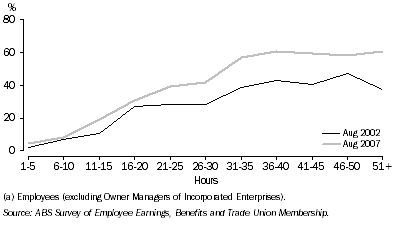
OCCUPATION
Paid maternity leave entitlements are considerably more prevalent in the higher skilled occupations than the lower skilled occupations. In August 2007, the occupation group with the highest proportion of female employees (
end note 1) with paid maternity leave entitlements was Managers and administrators (69%), while the lowest was Elementary clerical, sales and service workers (20%). The low level of paid leave entitlements in the Elementary clerical, sales and service workers (and Labourers and related workers) occupation group reflects the relatively high concentration part-time and lower-paid employees (
end note 1) in these occupation groups.
Between August 2002 and August 2007, the Managers and administrators occupation group had the largest percentage point increase in the incidence of paid maternity leave entitlements (from 44% to 69%), while the Elementary clerical, sales and service workers occupation group had the smallest increase (from 14% to 20%).
7. Female employees(a) entitled to paid maternity leave, by Occupation(b)
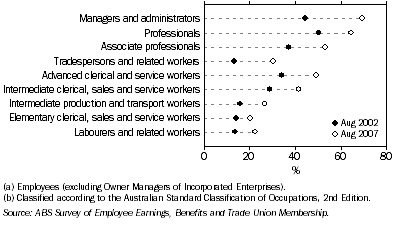
SECTOR AND INDUSTRY
Paid maternity leave entitlements are much more prevalent in the public sector than the private sector, with 73% of female public sector employees (
end note 1) having paid maternity leave entitlements compared with 36% of female private sector employees (
end note 1). However, between August 2002 and August 2007, there was a much greater proportional increase for the private sector than the public sector, albeit from a much lower base. The proportion of female employees (
end note 1) with paid maternity leave entitlements in the private sector increased by almost two-thirds compared with an increase of less than one-quarter for the public sector.
8. Female employees(a) entitled to paid maternity leave, by Sector
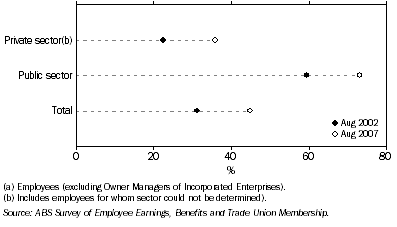
Graph 9 shows the proportion of female employees (
end note 1) with paid maternity leave entitlements for a range of selected industries (the industries which had the highest numbers of female employees (
end note 1) at August 2007). Of the selected industries, Government administration and defence (81%), Finance and insurance (67%) and Education (65%) had the highest proportion of females employees (
end note 1) with paid maternity leave entitlements. The high level of paid maternity leave entitlements within the Government administration and defence and Education industries reflects the large contribution the public sector makes to these industries.
The industries with the lowest proportion of female employees (end note 1) with paid maternity leave entitlements were Accommodation, cafes and restaurants (14%) and Retail trade (21%). These industries have a high concentration of part-time and lower-paid employees.
Between August 2002 and August 2007, the largest increases (in percentage and percentage point terms) occurred in the Manufacturing, Finance and insurance, Property and business services and Wholesale trade industries. The Health and community services industry experienced the largest increase in the number of female employees (end note 1) with paid maternity leave entitlements (166,000) over the same period.
9. Female employees(a) entitled to paid maternity leave, by Selected Industries(b)
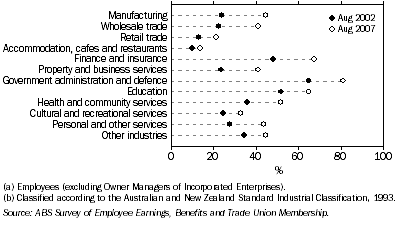
DURATION WITH EMPLOYER
There is a high correlation between the length of time a person works for an employer and the entitlement to paid maternity leave. This is the case for both full-time and part-time employees (
end note 1).
Graph 10 shows that just 22% of female employees (end note 1) who had worked for their current employer for under 3 months had paid maternity leave entitlements, compared with 71% of female employees (end note 1) who had worked for their current employer for 20 years or more.
10. Female employees(a) entitled to paid maternity leave, by Continuous duration with current employer
- Nov 2007
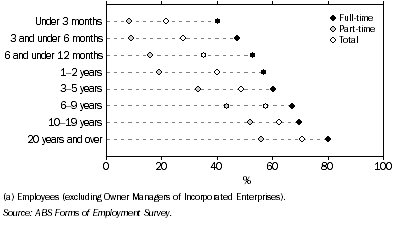
This relationship can also be seen when looking at the length of time a person expects to be working for their current employer. Over 60% of full-time female employees (
end note 1) who expect to be with their current employer for at least 12 months have an entitlement to paid maternity leave, compared with 45% of those who do not expect to be with their current employer in 12 months time (see Graph 11).
11. Female employees(a) entitled to paid maternity leave, by Expected future duration with current employer
- Nov 2007
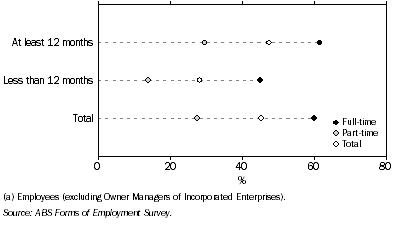
STATES AND TERRITORIES
The state or territory with the highest proportion of female employees (
end note 1) entitled to paid maternity leave was the ACT (66%), followed by the NT (57%). Female employees (
end note 1) in Western Australia and Queensland had the lowest incidence of paid maternity leave entitlements (both 41%). Variations in paid maternity leave entitlements across the states and territories generally reflects differences in the composition of the labour market within each of the states or territories. For example, the high level of paid maternity leave entitlements in the ACT and the NT reflects the large proportion of public sector employees (
end note 1) within these territories.
In the five years to August 2007, the largest percentage increases in the proportion of female employees (end note 1) entitled to paid maternity leave were in South Australia and Western Australia, while the lowest increases were in the NT and ACT.
12. Female employees(a) entitled to paid maternity leave, by State/Territory
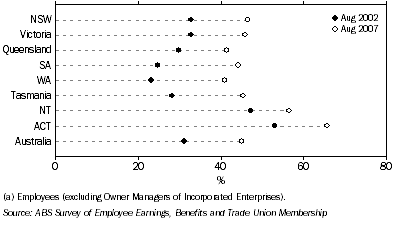
REGIONS
Overall, a higher proportion of employees (
end note 1) in capital cities had an entitlement to maternity leave than those employees (
end note 1) in the balance of state (46% compared with 43%). However, this difference was driven by differences in paid maternity leave entitlements for part-time employees (
end note 1) (28% compared with 26%), as full-time employees (
end note 1) in capital cities and balance of state had the same incidence of paid maternity leave entitlements (60%).
While for full-time employees (end note 1) there was no difference between capital cities and balance of state at the Australia level, looking at the individual states provides a different perspective. With the exception of NSW, the proportion of full-time employees (end note 1) with paid maternity leave entitlements in the state capitals was higher than the balance of their respective states. However, a higher proportion of full-time employees (end note 1) in the balance of NSW were entitled to paid maternity leave than those in Sydney (65% compared with 60%).
FURTHER INFORMATION
For further information about paid maternity leave entitlements, or the Employee Earnings, Benefits and Trade Union Membership or Forms of Employment surveys, please contact Michael Gerrity on Canberra (02) 6252 5514 or email <m.gerrity@abs.gov.au>.
END NOTES
1. Employees (excluding Owner Managers of Incorporated Enterprises).
 Print Page
Print Page
 Print All
Print All